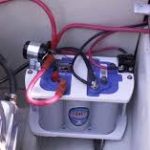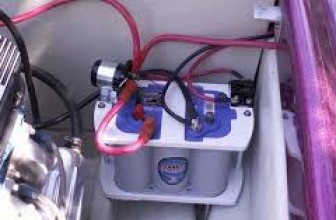Owning a trolling motor battery is different to a starter battery on a boat because it is a deep cycle variety or dual-purpose one. It has a long lifespan and gets up to a full charge quicker too.
With any kind of battery, it’s necessary to perform basic maintenance on them to keep it functioning well. Without maintenance, the battery will gradually deteriorate and then outright fail. If out on the water when the battery dies on you and won’t charge back up, your trolling motor won’t function. If you’re using the trolling motor because your main starter battery is drained, then you’re completely out of luck at that point. You’ll have to get on the radio to get rescued because you’re now stranded out on the water.
Charging up a trolling motor isn’t hard. When charging a trolling motor battery properly, it won’t take that long. We will run through how to do that a variety of different ways in this article.
Best Options to Charge Up a Trolling Motor Battery
Way back in the day, these batteries were recharged by moving battery acid around within the container of the battery. It worked, but it was a slow approach and needed physical effort over a period of time to get the necessary result. It was a real pain, basically. Thankfully, battery technology has progressed since then.
There’s no one method for recharging in a modern way through because there’s not one type of trolling motor battery, but several. As such, they require a different approach to charging to get them to work. Different chargers are required in some cases too. It sounds complicated, but we’ll explain.
Different Trolling Motor Battery Types
Here are the three types of trolling motor battery:
- AGM Absorbed Glass Mat Battery
These are easy to charge. They’re flexible enough to charge using a solar panel pack, an outboard or onboard charger. They also charge up quickly too.
With AGM batteries, overcharging will damage them and reduce their lifespan. It’s charging cycle must be reviewed closely to avoid damaging it.
- Sealed Gel Batteries
The sealed gel variety uses acid. They’re no problem to charge up. The battery includes an agent that helps make the internal material thicker to prevent leaks.
With this type of battery, dead cells make it harder to refill the battery as a whole. Therefore, avoid killing-off battery cells by either undercharging the battery or overcharging it.
- Flooded Cell Batteries
The flooded cell battery is currently the most popular. It is also easier to charge up. The acid goes into the battery container. A negative plate is used during this process which delivers an electrical response in the battery’s cells.
The risk with this battery is acid spills which can burn the skin or eyes badly. Caution is required when charging these batteries.
- Charging Batteries Using Solar Power
A trolling motor can be charge with solar power. A solar panel and other equipment are needed to do this.
Simply position the solar panel on the boat. A higher position is better to catch more sun rays. A boost converter is useful to take low voltage and convert it successfully. A relay circuit is useful when charging more than one battery.
Charging using solar is not totally reliable. You can need to recharge right away, and the sky is overcast. Or, it can be late in the afternoon delivering too little juice to charge the battery. Slow charging is common with a solar panel, but it usually works. Patience is required.
- Charging Batteries Using a Portable Charger
A portable charger is very convenient to charge a deep cycle battery. They are not too heavy to carry onto and off the boat.
The portable charger is not left attached to the battery. It is attached, completes the charging cycle and then is disconnected again. A few models are pretty durable, and they last a good amount of time. They certainly charge a battery faster than solar in most cases.
- Charging Batteries Using an On-Board Charger
With onboard Marine battery chargers, then come in three varieties:
- Precision
- DC alternator
- Digital
Each works well and charges a battery quickly. The precision models can charge all types of batteries. You select the battery type first.
Here are some questions to ask about battery chargers:
- Battery Type?
The battery type will either be gel, flooded or AGM. The gel batteries need a special type of charger, but the other battery types work with most chargers.
- What’s the Amperage of my Battery?
Because batteries vary in size, their amps also differ from make, model and size battery to another. For instance, with a 50-amp hour battery, a charge that can deliver 6-8 amps is going to be plenty. The rate matters because it determines both the speed of the charging process and the durability of the battery.
- What If You Need to Charge a Battery While Boating?
Not all batteries do well when charging on the water. Each battery charger is designed to be used in a different way, so it’s important to verify that before purchase. Most chargers can adjust the rate of charge to suit the situation too.
Bear in mind that AGM chargers can provide a speedy charge when the boat is out, but that can damage the cells in the battery, along with the separators and metal plates too. For AGM chargers, set them at a minimal amperage to avoid damaging them.
- Do’s and Don’ts
The Dos:
- Arriving on-shore, charge the batteries every time
- Keep the top of the batteries clean. If they have a lake or sea water on them, dry them off. This avoids the terminals getting damaged making them not accept a charge
- A solar power charger that uses a smart controller to slowly trickle charge the battery is useful and extends the life of the battery in many cases
The Don’ts:
- When using more than one battery, stick to a single type. Don’t mix them because it’s too easy to charge both and forget that they’re different.
- Avoid overcharging a battery at all costs. Nothing good comes of it
Take battery charging seriously. They’re a vital piece of equipment but must be well-managed to use them properly.





